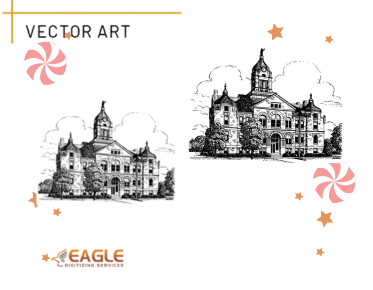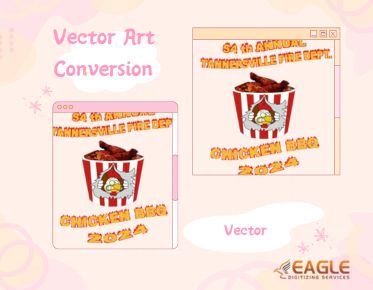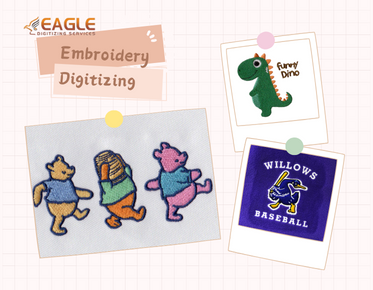Typography Secrets for Stunning Vector Embroidery Design
Typography in embroidery is more than just letters; it’s a nuanced art form that brings words to life through texture and thread. Typography matters in vector embroidery because it transforms simple text into compelling visual statements. The fusion of text and textiles creates a unique canvas where meaning and aesthetics intersect, allowing designers to express ideas and emotions in a tactile format. If this post piqued your curiosity and you wish to learn more about Embroidery Digitizing, feel free to reach out to us.
The Advantages of Vector Graphics for Embroidery Design
The benefits of vector graphics in embroidery are manifold. They enable precise control over shapes and lines, essential for intricate designs. Moreover, vector files are typically smaller in size, making them easier to manipulate and store. This precision ensures that every stitch is accurately rendered, resulting in a polished final product.
Choosing the Right Typeface for Embroidery
Serif vs. Sans-Serif: What Works Best?
When selecting a typeface for embroidery, the choice between serif and sans-serif fonts can significantly impact the outcome. Serif fonts add a classic touch with their decorative strokes, while sans-serif fonts often provide a cleaner, more modern look. For embroidery, simpler sans-serif fonts tend to yield clearer results, especially in smaller sizes.
Script Fonts: Elegance or Chaos in Stitching?
Script fonts can evoke elegance and fluidity, but they can also pose challenges. Their intricate designs may not translate well into stitches, leading to confusion in readability. Carefully consider the complexity of script fonts and test them thoroughly to ensure they deliver the desired effect without sacrificing clarity.
Display Fonts: Making a Bold Statement
Display fonts can make a strong impact, drawing attention with their unique shapes. When used thoughtfully, they can convey a brand’s personality or evoke a specific mood. However, ensure that they are legible in various sizes; bold statements should still be easy to read.
The Basics of Typography in Design
Key Typography Terms Every Designer Should Know
Understanding essential typography terminology, such as baseline, x-height, and kerning, is crucial for effective design. Each term informs how text appears and interacts with other design elements, influencing overall aesthetics.
Understanding Hierarchy: Importance of Size and Weight
Establishing a hierarchy in typography through size and weight helps guide the viewer's eye. Larger, bolder text can emphasize key messages, while smaller text can provide supporting details. This visual hierarchy is essential for creating a cohesive and engaging design.
Creating Legible Text in Embroidery
Size Matters: Finding the Right Font Size for Clarity
Choosing the right font size is pivotal in embroidery design. Text that is too small may lose detail and become illegible, while overly large text can overwhelm the design. Aim for a size that maintains clarity while integrating harmoniously with other elements.
Spacing: The Impact of Kerning and Leading on Readability
Kerning (the space between characters) and leading (the space between lines) play vital roles in legibility. Proper spacing enhances readability and ensures that letters don’t crowd each other, especially in stitched designs where a thread can create additional visual clutter.
Avoiding Overly Complex Fonts: When Simplicity Wins
Simplicity is key in embroidery typography. Overly complex fonts may lose their charm when translated into stitches, resulting in a muddled appearance. Opt for designs that maintain their integrity and clarity, even when stitched.
Color Theory in Typography for Embroidery
Choosing Colors that Pop Against Fabric Backgrounds
Selecting colors that stand out against fabric backgrounds is essential. Contrast is key; bright text on a dark background, or vice versa, can create striking visual effects. Consider the fabric's texture as well, as it can alter how colors appear when stitched.
The Psychology of Color: What Your Choices Say
Colors convey emotions and messages. For instance, blue often symbolizes calmness, while red can evoke excitement. Understanding color psychology can help you choose hues that align with the intended message of your design.
Using Color Gradients and Effects in Vector Design
Incorporating gradients can add depth and dimension to your typography. Subtle shifts in color can create a dynamic appearance, making the text more visually appealing. However, be cautious—complex gradients may not translate well into embroidery, so test your designs thoroughly.
Transforming Text into Embroidery-Friendly Designs
Converting Text to Outlines: Why It’s Essential
Converting text to outlines is a crucial step in preparing typography for embroidery. This process ensures that the text becomes a shape that can be manipulated, preventing font compatibility issues and preserving the integrity of the design.
Simplifying Details: Adjusting Fonts for Stitching
Embroidery often requires simplifying font details to ensure clean stitching. Reduce intricate features or excessive embellishments that may not translate well. Focus on maintaining the essence of the font while adapting it for stitching.
Creating Custom Lettering: Personalizing Your Design
Custom lettering can add a personal touch to your designs. Crafting unique letters allows for greater creativity and expression, ensuring that your typography stands out. Embrace the opportunity to infuse personality into your work.
Digitizing Text for Embroidery Machines
The Process of Digitizing: Turning Vector into Stitch
Digitizing transforms vector designs into stitch instructions for embroidery machines. This intricate process requires software and knowledge of stitch types to ensure that the design accurately reflects the intended outcome.
Common Software Options for Digitizing Text
Several software options cater to digitizing needs, such as Wilcom, Hatch, and Embrilliance. Each offers unique features and capabilities, allowing designers to choose the best fit for their workflow.
Understanding Stitch Types: Satin vs. Fill
Familiarize yourself with different stitch types. Satin stitches create smooth, clean lines ideal for outlines, while fill stitches add texture and coverage to larger areas. Selecting the appropriate stitch type is essential for achieving the desired effect.
Choosing the Right Stitch Types for Typography
Satin Stitch: When to Use for Clean Lines
Satin stitches are perfect for clean, polished lettering. They provide a luxurious finish and work well for intricate designs, offering a sleek appearance when executed correctly.
Fill Stitch: Adding Texture and Depth
Fill stitches can add richness to typography, enhancing visual interest. However, they require careful consideration of fabric type and thickness to ensure that the design maintains clarity and texture.
Running Stitch: A Simple Approach for Minimalist Designs
Running stitches offer a minimalist aesthetic, suitable for simple designs. They are easy to execute and can create a charming hand-stitched look, perfect for casual or rustic themes.
Balancing Typography and Graphics in Your Design
Integrating Text with Imagery: Finding Harmony
Achieving harmony between typography and imagery is vital for a cohesive design. Text should complement graphic elements, creating a seamless integration that enhances the overall visual appeal.
Using Negative Space to Enhance Readability
Negative space plays a crucial role in design. Adequate spacing around text prevents clutter and enhances readability, allowing the viewer’s eye to navigate the design effortlessly.
Avoiding Clutter: Keeping It Simple and Elegant
Simplicity is key to effective design. Avoid overcrowding your work with too many elements, focusing on a clean and elegant presentation that showcases your typography and graphics effectively.
Testing Your Typography Designs
Sample Stitches: Why You Should Always Test First
Testing your designs with sample stitches is essential to identify potential issues. This practice allows you to see how your typography translates to fabric, ensuring that the final product meets your expectations.
Adjusting Based on Feedback: Learning from Samples
Gather feedback from your samples to refine your designs. Observing how others perceive your typography can provide valuable insights, helping you make necessary adjustments for improvement.
Common Mistakes in Typography for Embroidery
Overly Complicated Fonts: The Trouble with Details
One of the most common mistakes is selecting overly complicated fonts. Intricate details may get lost in stitching, leading to illegibility. Aim for clarity and simplicity to ensure your text stands out.
Ignoring Fabric Texture: How It Affects Text Appearance
Fabric texture significantly impacts how typography appears. Consider the fabric's characteristics when designing; a rough texture may alter how smooth lines are perceived. Choose fonts that adapt well to the fabric type.
Neglecting the Final Application: Designing for Purpose
Always keep the end application in mind when designing typography. Whether for apparel, home décor, or promotional materials, ensure that your typography aligns with its intended use and audience.
Using Typography to Tell a Story
Crafting Messages that Resonate: The Power of Words
Typography has the power to convey messages that resonate deeply with viewers. Consider the words you choose and how they relate to the visual elements, creating a narrative that captures attention.
Incorporating Quotes and Sayings: Tips for Impactful Text
Quotes and sayings can add depth to your designs. Select impactful phrases that complement your visuals, ensuring they resonate with the audience while enhancing the overall message.
Embracing Trends in Typography for Embroidery
Current Typography Trends: What’s Popular Now?
Staying updated with typography trends is vital for modern design. Popular trends may include bold fonts, minimalism, and vintage styles, each offering unique opportunities for creative expression.
Vintage and Retro Styles: Nostalgic Design Choices
Vintage typography evokes nostalgia, creating a sense of warmth and familiarity. Incorporating retro styles can add character to your designs, appealing to audiences seeking a connection to the past.
Incorporating Personal Branding with Typography
Creating a Unique Look for Your Business or Project
Typography is vital in developing a brand's identity. Choose fonts that reflect your brand's personality and values, creating a cohesive look across all materials.
The Importance of Consistency Across Designs
Consistency in typography strengthens brand recognition. Use a limited set of fonts and styles throughout your designs to create a unified aesthetic that resonates with your audience.
The future of typography in embroidery design is bright and filled with endless possibilities. By embracing new techniques and technologies, designers can explore innovative ways to integrate text and textiles. The fusion of these two art forms promises to transform how we communicate through embroidery, continually inspiring creativity and expression.



